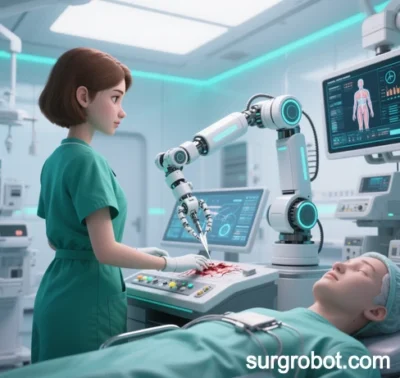
Surgical Robots: Core Features and Cutting-Edge Advancements
As the “crown jewel” of high-end medical devices, surgical robots are redefining modern surgical paradigms through multidisciplinary technological integration. This article provides a systematic analysis from two key dimensions: core features and latest advancements.
I. Core Features: The Technological Foundation of Surgical Robots
Precise Control and Submillimeter Operational Precision
Surgical robots achieve superhuman hand stability through high-precision servo motors (with errors <0.1mm), nanometer-level gear reducers, and multi-degree-of-freedom robotic arms (typically 4–7 axes). For example, the EndoWrist instruments of the Da Vinci Xi system can simulate 540° wrist rotation, eliminating physiological tremors.
Revolutionizing Minimally Invasive Surgery
Using 5–8mm micro-instrument channels and 3D endoscopic systems, surgical incisions are reduced to one-tenth the size of traditional open surgeries. Clinical data shows that robot-assisted prostatectomy reduces intraoperative blood loss by 65% and shortens hospital stays by 40%.
Modular System Architecture
A typical system comprises three main modules:
- Master Console: Integrates naked-eye 3D display and force-feedback interfaces (e.g., tactile reproduction technology in Toumai MT1000).
- Robotic Arm Platform: Supports quick replacement of over 20 specialized tools, such as orthopedic drills and electrosurgical knives.
- Intelligent Navigation System: Combines pre-operative CT/MRI and intra-operative O-arm real-time imaging for submillimeter path planning.
Multimodal Sensing Fusion
New-generation systems integrate:
- Optical navigation (NDI Polaris spectral tracking)
- Force feedback (0.02N resolution tactile sensing in MicroHand S)
- Bioelectrical signal monitoring (EMG/EEG fusion in neuro-monitoring robots like NaoTrac)
Enhanced Human-Robot Collaboration
AI-assisted decision systems (e.g., Huake Jingzhun’s NeuroMaster) enable:
- Real-time intraoperative risk alerts (vascular/nerve avoidance prompts)
- Automated phase execution (automatic depth locking for orthopedic drilling)
- Quantitative assessment of surgical skills
II. Latest Advancements: 2024–2025 Technological Breakthroughs and Application Expansions
Technological Innovations
-
Deep Integration of AI and Machine Learning
The fifth-generation Da Vinci system, with a 10,000x 算力提升 (10,000x computing power increase), achieves autonomous path planning for lymph node dissection in prostate cancer surgery.
Longmu Valley’s AI orthopedic system, trained on 30,000 surgeries, improves hip replacement accuracy to 98.7%. -
Tactile Feedback Breakthroughs
The Avatera system uses magnetorheological fluid technology to reproduce quantitative tactile differences in tumor hardness (0.05N resolution).
The 微创图迈 MT1000 (Weichuang Toumai MT1000) is equipped with 7D force sensing to detect 0.5mm variations in blood vessel wall thickness. -
5G Remote Surgery Normalization
Shanghai Weichuang’s “thoracoabdominal remote surgical robot” obtained NMPA approval, enabling 3,000km cross-region surgery (latency <30ms).
Qilu Hospital completed the world’s first robot-assisted 3D-printed jawbone reconstruction, transmitting 1.2TB of data via 5G during surgery. -
Miniaturization and Single-Port Technology
Medtronic’s Hugo RAS system reduces instrument diameter to 3mm, performing total hysterectomy through a single incision.
Harvard University developed millimeter-scale magnetically controlled micro-robots capable of autonomous intravascular drug delivery.
Clinical Application Expansion
-
Cross-Specialty Penetration
Department Representative Application Technological Highlights Neurosurgery ROSA deep brain electrode implantation (0.15mm error) Multimodal image fusion and tremor compensation Cardiovascular CorPath GRX vascular intervention (90% radiation reduction) Precise robotic guidewire steering Thoracic Surgery Monarch transbronchial lung nodule biopsy Electromagnetic navigation + real-time AI pathology Gastroenterology Invendoscopy single-operator colonoscopy system Autonomous lumen navigation and polyp marking -
Pushing Complex Surgery Boundaries
Peking Union Hospital completed robot-assisted total pancreatectomy with autologous islet transplantation, reducing vascular anastomosis time to 18 minutes.
Zhongshan Hospital performed mitral valve repair on a beating heart using the Edge MP1000. -
Emergency and Field Medicine Innovations
The U.S. military’s MURG system supports robotic trauma surgery in field tents (30-minute rapid deployment).
BGI’s remote ultrasound robot enabled tomographic diagnosis in earthquake-stricken areas.
Market and Policy Developments
-
Accelerated Domestic Substitution
By 2025, domestic laparoscopic robot market share exceeds 25%, with key component localization rates:- Servo motors: 80%
- Gear reducers: 65%
- High-precision sensors: 50%
-
Global Market Explosive Growth
The global market is projected to reach $63.1 billion by 2030 (CAGR 25.6%), with China’s market exceeding 70 billion RMB.
Orthopedic robot penetration is expected to rise from 0.7% in 2025 to 3.5% in 2030—double the current U.S. level. -
Policy-Driven Momentum
Changping District’s “Three-Year Robot Industry Action Plan” mandates:- Establishment of a national surgical robot testing center by 2026
- Inclusion of 5G remote surgery in medical insurance coverage
Under the FDA’s accelerated approval pathway, 23 surgical robots received 510(k) clearance in 2024—a 40% year-on-year increase.
Ethics and Standardization
-
AI Accountability Framework
The International Medical Robotics Association (IMRA) released the Autonomous Surgery Grading Standard:Level Autonomy Degree Example L1 Tool assistance Traditional robotic arms L2 Task-specific automation Orthopedic drilling depth control L3 Conditional autonomous decision AI vascular anastomosis path planning L4 Full-process autonomy (with monitoring) AI system for intestinal polyp resection -
New Data Security Paradigm
The EU’s Medical Robot Data Act requires:- Local encrypted storage of intraoperative data (AES-256 standard)
- Quantum key distribution (QKD) channels for remote surgery
III. Future Trends and Challenges
Technological Convergence Frontiers
- Quantum Biocomputing: IBM and the Cleveland Clinic are developing quantum optimization algorithms to reduce robot-assisted prostatectomy time to 23 minutes.
- Brain-Computer Interface Control: Neuralink’s implantable chip achieves intuitive robotic arm control for amputees (92% success rate in animal trials).
Clinical Translation Hurdles
- Cost Control: Current device prices ($1.2–2.5 million) must drop below $500,000 for grassroots adoption.
- Training Gap: A global shortage of 120,000 qualified robotic surgeons calls for VR + digital twin training platforms.
Ethical New Frontiers
- Boundary of “Enhanced Medicine”: The U.S. NIH halted a “vision-enhanced orthopedic robot” clinical trial over non-therapeutic function improvements.
- Algorithmic Liability Tracing: A Massachusetts court first ruled that surgical robot AI systems bear 15% joint liability.
Surgical robots are evolving from “precise tools” to “intelligent surgical teams.” With the integration of embodied intelligence and quantum computing, the next decade may witness the birth of “autonomous surgical pods” and “cell-level surgical robots,” ultimately driving a fundamental 重构 (restructuring) of surgical diagnostics and treatment.
Data sourced from public reference materials. For collaborations or domain name inquiries, contact: chuanchuan810@gmail.com.




